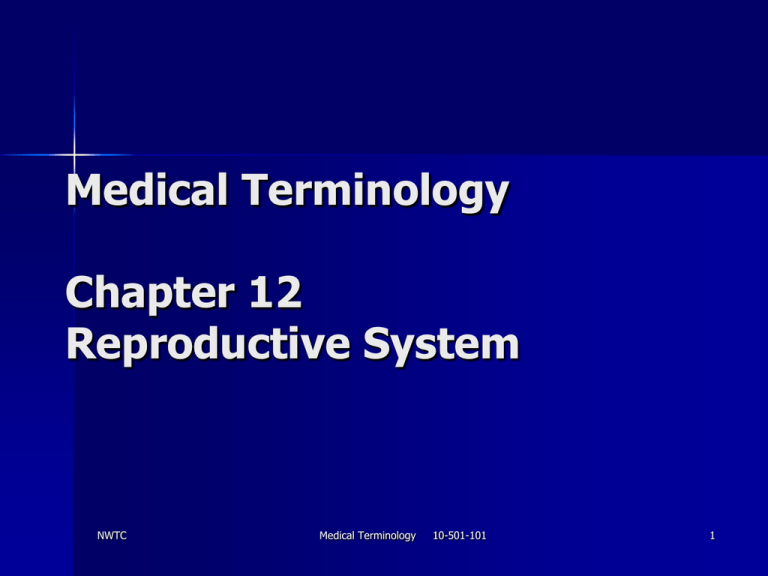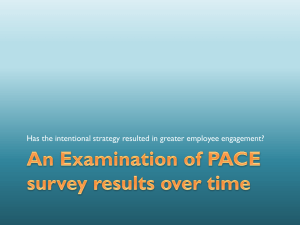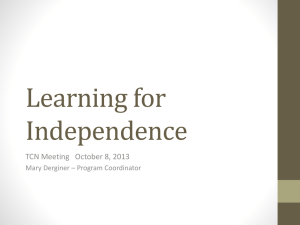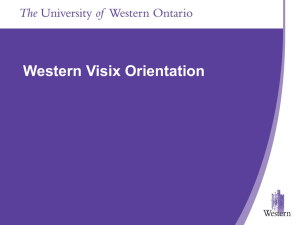
Medical Terminology
Chapter 12
Reproductive System
NWTC
Medical Terminology
10-501-101
1
Function
The male and female reproductive
systems include the gonads (ovaries
and testes), where sex cells and
hormones are produced, and other
organs, ducts, and glands that
transport and sustain the egg or
sperm cell.
NWTC
Medical Terminology
10-501-101
2
Anatomy and Physiology
Female reproductive system includes:
– Ovaries produce
–
–
–
–
–
NWTC
Sex cells
Hormones
Uterine tubes
Uterus
Vagina
Accessory glands
External genital structure
Medical Terminology
10-501-101
3
Anatomy and Physiology
Combining word form genit(o)
Organ of reproduction
Another word form for genitals is
Genitalia
Uro/genit/al means
Pertaining to the urinary and
reproductive system
NWTC
Medical Terminology
10-501-101
4
Anatomy and Physiology
Combining word form means woman or
female
Gynec(o)
The medical specialty that treats disease of
the female reproductive tract is:
Gynecology
Gynecoloc/ic means pertain to gynecology
or
Study of diseases that occur only in female
NWTC
Medical Terminology
10-501-101
5
Anatomy and Physiology
Internal structures
– Left ovary and associated left
fallopian/uterine tube
– Right ovary and associated right
fallopian/uterine tube
– Uterus
– Vagina
– Special glands
NWTC
Medical Terminology
10-501-101
6
Anatomy and Physiology
Combining word form ovari(o)
Structure of the ovary
Suffix –an means
Pertaining to
Ovarian means
Pertaining to the ovary
Combining word form oophor(o)
Diagnostic and surgical terms
NWTC
Medical Terminology
10-501-101
7
Anatomy and Physiology
Disease of the ovaries is
oophoropathy
Combining word form salping(o) means
Uterine tube
Surgical removal of a uterine tube is
Salpingectomy
Combining word forms uter(o) hyster(o)
and metr(o) means
Uterus
NWTC
Medical Terminology
10-501-101
8
Anatomy and Physiology
Greeks use the word hysterikos to refer to
Suffering in the womb
Emotional upheaval caused by this suffering
Combining word forms vagin(o) and
colp(o) means
Vagina
Combining word form cysto(o) means
Bladder
NWTC
Medical Terminology
10-501-101
9
Anatomy and Physiology
External structures
– Mons pubis
– Labia majora
– Labia minora
– Clitoris
– Prepuce
– Opening to glands
Paraurethral
Vestibular
NWTC
Medical Terminology
10-501-101
10
Anatomy and Physiology
Combining word form vulv(o) means
External genitalia in the female
Vulv/ar or vulv/al pertains to the
Vulva
Vestibule is
Any space or cavity at entrance to a canal
Combining word form perine(o) means
Perineum
NWTC
Medical Terminology
10-501-101
11
Anatomy and Physiology
Combining word form cervix means
Neck
Colpo/cervic/al refers to
Vagina and cervix
NWTC
Medical Terminology
10-501-101
12
Anatomy and Physiology
Combining word form metr(o) means
Uterus or to measure
The uterus is composed of three layers
of tissue
Perimetrium outer most layer
Myometrium middle layer
Endometrium means inner most layer
NWTC
Medical Terminology
10-501-101
13
Anatomy and Physiology
Prefix peri- means
Around
Combining word form my(o) means
Muscle
NWTC
Medical Terminology
10-501-101
14
Anatomy and Physiology
Monthly cycle of growth and discharge of
endometrium is
Menstrual cycle
Hypothalamus and pituitary gland secrete
hormones that act on the ovaries
– Production of ova
– Production of estrogen
– Production of progesterone
NWTC
Medical Terminology
10-501-101
15
Anatomy and Physiology
Cyclic bloody discharge from shedding of
the endometrium
Menstruation
Female reproductive cycle begins at
Puberty
The first menstruation is the
Menarche
Natural cessation of reproductive cycle is
Menopause
NWTC
Medical Terminology
10-501-101
16
Anatomy and Physiology
Secretion of female reproductive
hormones follows monthly cyclic
patterns that affect the ovaries and
uterus
Ovarian cycle
Menstrual (uterine) cycle
NWTC
Medical Terminology
10-501-101
17
Anatomy and Physiology
Ovarian phase
Follicular phase days 1-5/6-12
Growth of follicle
Secretion of estrogen
Ovulation is days 13-14
Ova released by the follicle
Luteal phase days 15-28
Follicle becomes corpus luteum
Secretes progesterone
NWTC
Medical Terminology
10-501-101
18
Anatomy and Physiology
Uterine (menstrual) phase
Menses days 1-5
Blood is shed form the vagina
Proliferative phase days 6-12/13-14
Growth of the endometruim
Proliferative phase continues
Secretory phase days 15-28
Continued growth of endometruim
Secretion of glycogen
NWTC
Medical Terminology
10-501-101
19
Diagnostic Tests & Procedures
Physical assessment of female
reproductive system includes
Breasts
External genitalia
Pelvis
Instrument for examining vagina
Vaginal speculum
NWTC
Medical Terminology
10-501-101
20
Diagnostic Tests & Procedures
Cyto/logy is
Study of cells
Cells of cervix examined to detect
vaginal infections
Yeast, Bacteria,Trichomonas
Pap smear for
Cancer cells
NWTC
Medical Terminology
10-501-101
21
Diagnostic Tests & Procedures
Suffix –plasia means development or
formation
Prefix dys- means bad
Dysplasia mean
Abnormal (bad) development of cervical
cells
Colposcopy is using a colposcope to magnify
the mucosa of the vagina and cervix
NWTC
Medical Terminology
10-501-101
22
Diagnostic Tests & Procedures
Cervical biopsy
Endometrial biopsy
Hysteroscopy
Direct visualization of cervical canal
and uterine cavity
Excision of cervical polyps or biopsy
NWTC
Medical Terminology
10-501-101
23
Diagnostic Tests & Procedures
Detecting masses
– Pelvis ultrasonography
– Computed tomography (CT scan)
Radiologic examination of uterus and
fallopian tubes
Hystersalpingography
Often done to look for obstruction of
fallopian tube
NWTC
Medical Terminology
10-501-101
24
Diagnostic Tests & Procedures
Examination of abdominal cavity with
a laparoscope
Can be done to view pelvic cavity
Laparoscopy
NWTC
Medical Terminology
10-501-101
25
Pathologies
Menorrhagia
Abnormally heavy or long menstrual
period
Metorrhagia
Hemorrhage of the uterus
NWTC
Medical Terminology
10-501-101
26
Pathologies
Amenorrhea
Absence of menstruation
Dysmenorrhea
Painful or difficult menstruation
Mittelschmerz
Abdominal pain in the region of the
ovary during ovulation
NWTC
Medical Terminology
10-501-101
27
Pathologies
Premenstrual syndrome (PMS)
Nervous tension, irritability, edema,
headache, and painful breasts that can
occur the last few days before the
onset of menstruation
NWTC
Medical Terminology
10-501-101
28
Pathologies
Cervicitis
Inflammation of the cervix
Possible Causes
– Chlamydia
– Yeast (Candida ablicans)
– Trichomonas vaginalis
– Gonorrhea
NWTC
Medical Terminology
10-501-101
29
Pathologies
Vaginitis
Inflammation of vaginal tissues
Possible causes
– Sexual intercourse
– Following childbirth
– After taking antibiotics
Colpitis
NWTC
Medical Terminology
10-501-101
30
Pathologies
Vulvitis
Inflammation of vulva
Vulvovaginitis
Inflammation of vulva and vagina
NWTC
Medical Terminology
10-501-101
31
Pathologies
Oophoritis
Inflammation of an ovary
Oophoralgia
Ovarian pain
Oophorosalpingitis
Inflammation of an ovary and fallopian
tube
NWTC
Medical Terminology
10-501-101
32
Pathologies
Anovulation
Absence of ovulation
Possible causes
– Altered ovarian function
– Side effects of medications
– Result of disease
– Stress
NWTC
Medical Terminology
10-501-101
33
Pathologies
Polycystic ovary syndrome
– Anovulation
– Amenorrhea
– Infertility
Caused by
– Increased levels of testosterone,
estrogen, and lutenizing hormone and
decreased secretion of FSH
NWTC
Medical Terminology
10-501-101
34
Pathologies
Ovarian Cancer
Leading cause of death from
reproductive cancers
Difficult to diagnose
Usually spread by the time it is found
Sonography or CT scan to look for
ovarian mass
Often requires exploratory surgery
NWTC
Medical Terminology
10-501-101
35
Pathologies
Salpingocele
Hernial protrusion of a fallopian tube
Salpingitis
Inflammation of a fallopian tube
Ectopic pregnancy
Outside the uterine cavity
Tubal pregnancy
Implanted in the fallopian tube
NWTC
Medical Terminology
10-501-101
36
Pathologies
Pelvic inflammatory disease (PID)
Infection that involves the upper genital tract
beyond the cervix
Toxic shock syndrome (TSS)
–
–
–
–
–
Sudden high fever
Headache
Confusion
Acute renal failure
Abnormal liver function
Caused by staphylococcus
Most common among women who use tampons
NWTC
Medical Terminology
10-501-101
37
Pathologies
Uterine cancer
Stage I uterus only
Stage II cervix also involved
Stage III spread beyond uterus but
still within pelvic cavity
Stage IV spread beyond the pelvis
most often spreading to liver and/or
lungs
NWTC
Medical Terminology
10-501-101
38
Pathologies
Hysteroptosis
Uterine prolapse
Uterine displacements
– Anteversion
– Retroversion
– Anteflexion
– Retroflexion
NWTC
Medical Terminology
10-501-101
39
Pathologies
Uterine leiomyoma
Uterine fibroid (benign tumor)
Cervical polyps
Myometritis
Inflammation of the myometrium
Endometritis
Inflammation of the endometrium
NWTC
Medical Terminology
10-501-101
40
Pathologies
Endometriosis
Abnormal condition in which endometrium
tissue is outside the uterus, usually within
the pelvic cavity
Vulvitis
Inflammation of the vulva
Leukorrhea
Normal white discharge before and after the
menstrual period
NWTC
Medical Terminology
10-501-101
41
Pathologies
Colpodynia
Pain of the vagina
Cystocele
Protrusion of the bladder through the
wall of the vagina
Rectocele
Rectum is displaced causing bulging of
the posterior vaginal wall
NWTC
Medical Terminology
10-501-101
42
Surgical & Therapeutic Interventions
An agent that prevents pregnancy
Prefix contra- (against)
Contraceptive
Hormone Replacement Therapy (HRT)
Combination of estrogen and progesterone
– Transition symptoms
– High risk for osteoporosis, abnormal loss of bone
density, and deterioration of bone tissue
NWTC
Medical Terminology
10-501-101
43
Surgical & Therapeutic Interventions
Treatments for infections of the vulva,
vagina, or cervix
– Oral antibiotics
– Topical antibiotics
– Vaginal creams
– Vaginal suppositories
NWTC
Medical Terminology
10-501-101
44
Surgical & Therapeutic Interventions
Suturing of the vagina is
Colporrhaphy
Surgical repair of the vagina is
Colpoplasty
Surgical fixation of an ovary is
Oophoropexy
NWTC
Medical Terminology
10-501-101
45
Surgical & Therapeutic Interventions
Oophoro/hyster/ectomy is
Removal of ovaries and uterus
Oophorectomy is
Removal of the ovaries
Oophorosalpingectomy is
Removal of uterine tube and an ovary
Salpingo-oophorectomy is
Removal of uterine tube and an ovary
Hyster/ectomy
Removal of the uterus
NWTC
Medical Terminology
10-501-101
46
Surgical & Therapeutic Interventions
Hysterectomy with bilateral
oophorosalpingectomy
Removal of the uterus and both ovaries
and both fallopian tubes
Colpo/hyster/ectomy is
Removal of uterus by way of the vagina
Laparo/hyster/ectomy is
Removal of uterus through a small
opening in the abdominal wall
NWTC
Medical Terminology
10-501-101
47
Surgical & Therapeutic Interventions
Excision of uterine tube is
Salpingectomy
Tubal ligation
Permanent sterilization
Dilation and curettage (D & C)
– Cervix dilated
– Scraping of endometrium
NWTC
Medical Terminology
10-501-101
48
Surgical & Therapeutic Interventions
Suffix –therapy means
Treatment
Treatment for dysplasia
Biopsy
Cryo/therapy
Cold treatment
Cautery
Irradiation
NWTC
Medical Terminology
10-501-101
49
Surgical & Therapeutic Interventions
Surgical fixation of a displaced uterus
Hysteropexy
Surgical fixation of uterine tube is
Salpingopexy
NWTC
Medical Terminology
10-501-101
50
Anatomy & Physiology-Male
Male reproductive system
Produces, sustains and transport
sperm
Introduces sperm into female vagina
Produces hormones
Primary organ of male reproductive
system is
Male gonads testes
NWTC
Medical Terminology
10-501-101
51
Anatomy & Physiology-Male
external
genitalia
–scrotum
–testicles
–penis
NWTC
Medical Terminology
10-501-101
52
Anatomy & Physiology-Male
internal
genitalia
–vas deferens
–prostate gland
–urethra
NWTC
Medical Terminology
10-501-101
53
Anatomy & Physiology-Male
sperm
–singular
spermatozoon
–plural
spermatozoa
NWTC
Medical Terminology
10-501-101
54
Anatomy & Physiology-Male
urologist
medical
doctor specializing in
treating diseases and disorders
of urinary system of females,
genitourinary system of males
NWTC
Medical Terminology
10-501-101
55
Pathology Of Male
Reproductive System
balanitis - inflammation of glans
penis
impotence - erectile dysfunction inability to achieve or maintain an
erection
phimosis - narrowing of foreskin
NWTC
Medical Terminology
10-501-101
56
Pathology Of Male
Reproductive System
anorchism - absence of one or
both testicles
cryptorchidism - undescended
testicles-one testicle fails to
descend into scrotum
epididymitis - inflammation of
epididymitis
NWTC
Medical Terminology
10-501-101
57
Pathology continued
hydrocele - hernia in the testicles or
tubes
testitis - inflammation of one or both
testes
varicocele - varicose vein of testicle
(may cause male infertility)
azoospermia - absence of sperm in
semen
NWTC
Medical Terminology
10-501-101
58
Pathology continued
oligospermia - low sperm count
benign prostatic hypertrophy BPH - enlarged prostate
prostate cancer - most common
cancer in males - slow or fast
growth
NWTC
Medical Terminology
10-501-101
59
Pathology continued
prostatitis - inflammation of the
prostate gland
prostatorrhea - discharge of
prostatic fluid through urethra
prostatomegaly – enlarged
prostate
NWTC
Medical Terminology
10-501-101
60
Diagnostic Procedures Of
Male Reproductive System
PSA - prostatic specific antigen - blood
screening test to check for cancer of
prostate
sperm analysis - sperm count - semen is
analyzed to determine sperm count,
shape, size and motility
TSE - testicular self-examination monthly self exam to check for
abnormalities
NWTC
Medical Terminology
10-501-101
61
Treatment Procedures Of
Male Reproductive System
circumcision - surgical removal of
foreskin
orchidectomy - surgical removal of
one or both testes
varicocelectomy - removal of
portion of enlarged vein to relieve
varicocele
NWTC
Medical Terminology
10-501-101
62
Treatment Procedures Of
Male Reproductive System
castration
- bilateral
orchidectomy - surgical
removal of both testicles
sterilization - procedure to
make individual incapable of
reproduction
NWTC
Medical Terminology
10-501-101
63
Treatments continued
vasectomy
- portion of vas
deferens is removed to
prevent sperm in semen
vasovasostomy - procedure
to restore fertility after
vasectomy
NWTC
Medical Terminology
10-501-101
64
Treatments continued
prostatectomy - surgical removal
of all or part of prostate gland
radical prostatectomy - surgical
removal of entire prostate gland,
seminal vesicles and some
surrounding tissue
NWTC
Medical Terminology
10-501-101
65
Treatments continued
TURP - transurethral resection of the
prostate - removal of all or part of
prostate through the urethra
radiation therapy - treatment to
control prostate cancer
hormone therapy - treatment to
control prostate cancer
NWTC
Medical Terminology
10-501-101
66
Medical Terminology
Chapter 13
Reproduction and Sexually
Transmitted Diseases
NWTC
Medical Terminology
10-501-101
67
Reproduction
Gonads
– Ovaries
– Testes
Produce ova and sperm
A gamete is a reproductive cell
– Ovum
– Spermatozoon
NWTC
Medical Terminology
10-501-101
68
Reproduction
Zygote
The product of fertilization
Suffix –blast means
Embryonic or early form
Ooblast is
Immature ovum
NWTC
Medical Terminology
10-501-101
69
Reproduction
Combining word form for amni(o) means
Amnion
Pertaining to amnion is
Amniotic
Combining word form chori(o)
Chorion
Pertaining to chorion is
Chorionic
Amniochorionic pertaining to 2 membranes
NWTC
Medical Terminology
10-501-101
70
Reproduction
Placenta
Highly vascular structure that nourishes the
fetus
Oxygen, nutrients, and antibodies diffuse
from the mother to fetal blood vessels
Fetal wastes diffuse from the fetal blood
into the maternal blood
Placenta secretes progesterone to maintain
the uterus during pregnancy
NWTC
Medical Terminology
10-501-101
71
Pregnancy and Childbirth
Prefix pre- means before
Combining word form nat(o) means
birth
Another name for pregnancy is
Prenatal period or gestation
A term that means childbirth is
Parturition
NWTC
Medical Terminology
10-501-101
72
Pregnancy and Childbirth
Average period of gestation is 266
days from the date of fertilization. (38
weeks)
Expected date of delivery 280 days
from the first day of the last menstrual
period. (40 weeks)
NWTC
Medical Terminology
10-501-101
73
Pregnancy and Childbirth
Suffix –gravida refers to
Pregnant female
Prefix primi- means
First
Primi/gravida is
Female during first pregnancy
Gravida I
NWTC
Medical Terminology
10-501-101
74
Pregnancy and Childbirth
Prefix multi- means many
multi/gravida means
Female pregnant more than once
Combining word form par(o) or suffix
–para means
Producing or bearing viable offspring
Par/ous refers to
Producing viable offspring
NWTC
Medical Terminology
10-501-101
75
Pregnancy and Childbirth
Para I means or primi/para is
Female produced one viable offspring
Prefix quadri- means
Four
Prefix nulli- means
None
Nulli/para
Produced no viable offspring
NWTC
Medical Terminology
10-501-101
76
Pregnancy and Childbirth
Labor
Process by which the child is expelled
from the uterus
Three stages of labor
– Cervical dilation
– Expulsion
– Placental and postpartum stage
NWTC
Medical Terminology
10-501-101
77
Pregnancy and Childbirth
4th stage – Postpartum
Hour or two after delivery when
uterine tone is established
Cesarean delivery
Surgical procedure in which the
abdomen and uterus are incised and
the baby is removed from the uterus
NWTC
Medical Terminology
10-501-101
78
Pregnancy and Childbirth
Postpartum – after birth
Prefix ante- means before
Ante/natal refers to
Time before birth
Prenatal also means the time before
birth
NWTC
Medical Terminology
10-501-101
79
Pregnancy and Childbirth
Postnatal means
Time after birth
Prefix neo- means new
Neo/natal refers to
First 28 days after birth
Neonate is a
Newborn child
NWTC
Medical Terminology
10-501-101
80
Pregnancy and Childbirth
Branch of medicine specializes in care
of newborn is
Neonatology
Physician specializes in neonatology is
Neonatologist
NWTC
Medical Terminology
10-501-101
81
Diagnostic Tests & Procedures
Human chorionic gonadotropin (HCG)
Hormone that is tested for in pregnancy
tests
Pelvimetry
Measurement of the pelvis used to estimate
the size of the birth canal
Cephalopelvic disproportion (CPD)
Baby’s head too large with birth canal too
small
Most likely a cesarean will need to be done
NWTC
Medical Terminology
10-501-101
82
Diagnostic Tests & Procedures
Sonography (Ultrasound)
Used to assess for structural
abnormalities and monitor fetal
development
Amniocentesis
Used to aid in the assessment of fetal
growth and diagnosis of genetic
defects or other abnormalities
NWTC
Medical Terminology
10-501-101
83
Diagnostic Tests & Procedures
Chorionic villus sampling
Used for prenatal diagnosis of potential
genetic defects
Fetoscope
Stethoscope for assessing fetal heart rate
Electronic fetal monitor
Used during labor to monitor the fetal heart
and record the fetal heart rate and maternal
uterine contractions
NWTC
Medical Terminology
10-501-101
84
Pathologies
Ectopic or extrauterine pregnancy
Whenever a fertilized ovum implants
anywhere other than the uterus (outside the
usual place)
–
–
–
–
Uterine tube
Ovary
Cervix
Abdominal cavity
Products of fertilization are removed
surgically
NWTC
Medical Terminology
10-501-101
85
Pathologies
Suffix –cyesis means pregnancy
Prefix pseudo- means false
False pregnancy is
Pseudo/cyesis
May be psychogenic or caused by a
physical disorder
NWTC
Medical Terminology
10-501-101
86
Pathologies
Preeclampsia
– Acute high blood pressure
– Proteinuria (protein in the urine)
– Edema
Eclampsia
– Seizures
– Coma
NWTC
Medical Terminology
10-501-101
87
Pathologies
Abruptio pregnancy
Separation of the placenta from the
uterine wall after 20 weeks
Placenta previa
Placenta is implanted abnormally in
the uterus
Stillbirth fetus died before or during
delivery
NWTC
Medical Terminology
10-501-101
88
Pathologies
Dystocia
Abnormal or difficult labor
Down syndrome
– Extra chromosome (#21)
– Moderate to severe mental retardation
– Additional genetic defects
NWTC
Medical Terminology
10-501-101
89
Pathologies
Hemolytic disease of the newborn
Maternal-fetal blood group
incompatibility
Erythroblastosis fetalis
Immature bed blood cell
Baby born anemic
NWTC
Medical Terminology
10-501-101
90
Pathologies
Fetal presentation entering birth
canal
Cephalic (normal) head
Breech buttocks
Shoulder
NWTC
Medical Terminology
10-501-101
91
Surgical & Therapeutic
Interventions
Amniotomy
Deliberate rupture of the fetal membranes
Oxytocin
Used as a drug to induce or augment
uterine contractions
Episiotomy
Surgical procedure in which an incision is
made in the female perineum to enlarge her
vaginal opening for delivery
NWTC
Medical Terminology
10-501-101
92
Surgical & Therapeutic
Interventions
Combining word form lapar(o) means
Abdominal wall
Incision of the abdominal wall is
Laparo/tomy
Suturing of the abdominal wall is
Laparorrhaphy
NWTC
Medical Terminology
10-501-101
93
Surgical & Therapeutic
Interventions
Contraception
Against conception
Birth control
– Oral
– Implants
– Patches
– Injectable
Intrauterine device (IUD)
NWTC
Medical Terminology
10-501-101
94
Surgical & Therapeutic
Interventions
Spermicide
Chemical substance that kills sperm
Permanent sterilization of a female is
Tubal ligation
Permanent sterilization of a male is
Vas/ectomy
vasovasostomy - procedure to restore
fertility after vasectomy
NWTC
Medical Terminology
10-501-101
95
Surgical & Therapeutic
Interventions
Hysterectomy (surgical removal of the
uterus)
Conception is not possible after surgery
Infertility
Condition of not being able to produce
offspring
In vitro fertilization (IVF)
Fertilization of the ova takes place outside
of the body
NWTC
Medical Terminology
10-501-101
96
Surgical & Therapeutic
Interventions
Abortion
Termination of a pregnancy before the
fetus is capable of surviving outside of
the uterus
Spontaneous – miscarriage
Deliberate
NWTC
Medical Terminology
10-501-101
97
Sexually Transmitted Diseases
Caused by infectious organisms passed
form one person to another through
Anal
Oral
Vaginal intercourse
NWTC
Medical Terminology
10-501-101
98
Sexually Transmitted Diseases
Venereal disease (STD’s) named for
Venus goddess of love
Causes of STD’s are
– Viruses
– Bacteria
– Protozoa
– Fungi
– Parasites
NWTC
Medical Terminology
10-501-101
99
Sexually Transmitted Diseases
Gonorrhea
Caused by gonococcus bacteria (gram
negative intracellular diplococci
Heavy urethral discharge in males
Females may be asymptomatic
Treated with penicillin
NWTC
Medical Terminology
10-501-101
100
Sexually Transmitted Diseases
Syphilis caused by a spirochete
Characterized by
Lymphadenopathy
Chancre
Congenital syphilis
NWTC
Medical Terminology
10-501-101
101
Sexually Transmitted Diseases
Chlamydia infection
symptom is
Dys/uria
Difficult (painful urination)
Complication PID
Herpes genitals
Viral infection characteristic
Genital blisters and ulceration
NWTC
Medical Terminology
10-501-101
102
Sexually Transmitted Diseases
Genital herpes during pregnancy can
cause
Spontaneous abortion
Stillbirth
Congenital birth defects
Prevented by cesarean section
NWTC
Medical Terminology
10-501-101
103
Sexually Transmitted Diseases
Condyloma acuminatum is commonly
called
Genital warts
At risk for cervical cancer
HIV virus causes
AIDS
Hepatitis B or Hepatitis C
NWTC
Medical Terminology
10-501-101
104
Sexually Transmitted Diseases
Trichomoniasis is caused by a
Protozoan
Candidiasis is an
Fungal infection
Vulvovaginitis
Inflammation of the vulva and vagina
Pubic lice
NWTC
Medical Terminology
10-501-101
105
Chapter 12 and 13
Class Exercises
NWTC
Medical Terminology
10-501-101
106
Meaning of Word Parts
Antebefore
colp(o)
vagina
metr(o)
uterine tissue or measure
cervic(o)
cervix, uteri or neck
-cyesis
pregnancy
NWTC
Medical Terminology
10-501-101
107
Meaning of Word Parts
Prebefore
ecto
situated outside
-para
female who has given birth
hyster(o)
uterus
extraoutside
NWTC
Medical Terminology
10-501-101
108
Meaning of Word Parts
Lapar(o)
abdominal wall
orchid(o)
testes
genit(o)
organs of reproduction
men(o)
month
gon(o)
genitals or reproduction
NWTC
Medical Terminology
10-501-101
109
Meaning of Word Parts
Multimany
primifirst
neo
new
post
after or behind
nullinone
NWTC
Medical Terminology
10-501-101
110
What is the Combining
Form?
Sperm
spermat(o)
egg
o(o)
ovary
oophor(o)
hidden
crypt(o)
NWTC
Medical Terminology
10-501-101
111
What is the Combining
Form?
birth
nat(o)
chorion
chori(o)
uterine tube
salping(o)
NWTC
Medical Terminology
10-501-101
112
Male - Female - Both
Laparohysteropexy
female
anorchism
male
endometrium
female
epididymitis
male
hysterosalpingogram
female
NWTC
Medical Terminology
10-501-101
113
Male - Female - Both
Metrorrhagia
female
vas deferens
male
uterine leiomyoma
female
toxic shock syndrome
female
orchidectomy
male
NWTC
Medical Terminology
10-501-101
114
What does it mean?
Formation of an opening into a
uterine tube
salpingostomy
outside of the uterus
extrauterine
occurring after birth
postnatal
surgical fixation of an ovary
oophoropexy
NWTC
Medical Terminology
10-501-101
115
What
does
it mean?
Inflammation
of the
prostate
prostatitis
pertaining to the testes
testicular
inflammation of the uterine lining
endometritis
uterine prolapse
hystoptosis
suture of the ductus deferens
vasorrhaphy
NWTC
Medical Terminology
10-501-101
116
Spelling
Prostratitis
prostatitis
menorhagia
menorrhagia
vulvektomy
vulvectomy
histerctomy
hysterectomy
varicosele
varicocele
NWTC
Medical Terminology
10-501-101
117
Spelling
Epididimitis
epididymitis
laporoscopy
laparoscopy
trichamoniasis
trichomoniasis
urojenital
urogenital
NWTC
Medical Terminology
10-501-101
118
What does it Mean?
Ovary
female gland
Amniocentesis
surgical puncture of the thin
membrane that covers the fetus
Myometritis
inflammation of the muscular
substance/layer of the uterus
NWTC
Medical Terminology
10-501-101
119
What does it Mean?
Fetus
3 month old developing organism
Circumcision
surgical removal of the prepuce
Prostatectomy
excision of all or part of the prostate
gland
Aspermatogenesis
absence of sperm production
NWTC
Medical Terminology
10-501-101
120
What does it Mean?
Cryptorchidism or cryptorchism
undescended testicle
Anorchism
congenital absence of testes unilateral
or bilateral, a synonym for anorchidism
Dilatation and Curettage
dilatation of the cervical opening and
scraping of the uterine wall
NWTC
Medical Terminology
10-501-101
121
What
does
it
Mean?
Laparoscopy
examination of the interior of the
abdomen with laparoscope, another
term for pelvic peritoneoscopy
Oophoropathy
any disease of the ovary
Salpingectomy
excision of an uterine tube
Hysteropexy
surgical fixation of the uterus
NWTC
Medical Terminology
10-501-101
122
What
does
it
Mean?
Oophoroma
ovarian tumor
Salpingoplasty
surgical repair of an uterine tube
Hysteromalacia
abnormal softening of the uterus
Colpoplasty
surgical repair of the vagina
Orchiepididymitis
inflammation of testicle and epididymis
NWTC
Medical Terminology
10-501-101
123
What is the Combining Form?
Uterine tube
salping(o)
Chorion
chori(o)
Birth
nat(o)
Hidden
crypt(o)
NWTC
Medical Terminology
10-501-101
124
What is the Combining Form?
Semen
semin(o)
Ovary
oophor(o)
Egg
o(o)
Sperm
spermat(o)
NWTC
Medical Terminology
10-501-101
125
What does it mean?
Antebefore
Extraoutside
Hyster(o)
uterus
-para
female who has given birth
NWTC
Medical Terminology
10-501-101
126
What does it mean?
Ectosituated outside
Prebefore
-cyesis
pregnancy
Cervic(o)
cervix, uteri, or neck
NWTC
Medical Terminology
10-501-101
127
What does it mean?
Metr(o)
uterine tissue or measure
Colp(o)
vagina
Laparohysterectomy
removal of the uterus
Laparotomy
incision of the abdominal wall
NWTC
Medical Terminology
10-501-101
128
What does it mean?
Abortion
termination of pregnancy before fetus
is capable of survival outside the
uterus
Human chorionic gonadotropin
a hormone that is present in body
fluids of pregnant females and forms
the basis of most pregnancy tests
NWTC
Medical Terminology
10-501-101
129
What does it mean?
Neonatologist
a physician who specializes in
conditions of newborns
Postnatal
the time after birth
Ectopic
outside the usual place
Salpingocyesis
tubal pregnancy
NWTC
Medical Terminology
10-501-101
130






